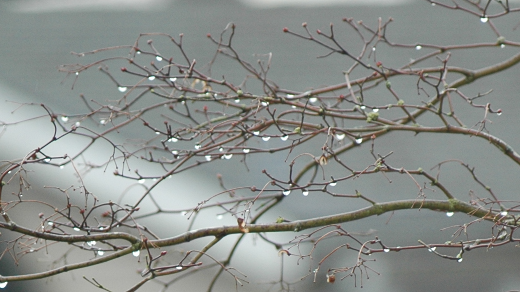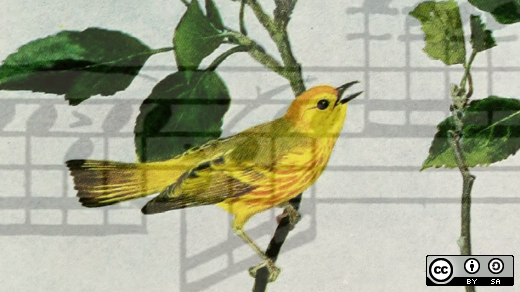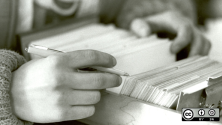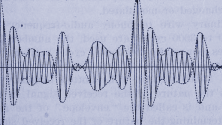We get a lot of rain in the Pacific Northwest, especially in the winter. But temperatures are also pretty mild, which gives us plenty of opportunity to get outside. Once we're outside—provided that we're paying attention—we can see and hear much of nature's subtle beauty that is too easy to miss while running errands or commuting. For example, we northwesterners often see drops of water clinging to branches and glowing as they refract the light.

And, of course, we hear things, too. In my case, hearing traffic at the airport is usually easy, courtesy of the wind coming from the southeast that brought the rain. And there is the usual local stuff—the occasional car, people walking and talking, birds singing, and so forth.
All this came to mind while I was listening to new music at Bleep Music, one of my go-to sites for independent music that is easy for Linux users to buy and download. The particular music that caught my attention and got me thinking about water drops in the trees was a new release from Biosphere called "Hilvarenbeek". As it turns out, Biosphere—or rather Geir Jenssen, the person who is Biosphere—is a field recordist, and Biosphere's EP "Hilvarenbeek" is the result of a stay at the farm of the same name in the Netherlands, and involved field recording and subsequent editing to layer on lovely sounds.
Field recording
Hmmm... field recording. Well, as usual, Wikipedia has a good overview of field recording, including a mention of the use of smartphones as a recording device. And sure enough, my Android smartphone's store includes a reference to several apps that work for field recording. So I started thinking about open source options, and that maybe Audacity installed on a Linux laptop could also do the job, especially if connected to a decent microphone.
I looked around and found Steven Burnham Smith's thesis, in which he discusses the rationale for an autonomous audio field recorder (PDF), which he builds using an Arduino as the core (although I imagine a good case could be made for using a Raspberry Pi). Of course, the musically inclined, once back home with their field recordings, could add—à la Biosphere— musical elements, using an open source synthesizer (for example, ZynAddSubFX) and an open source drum machine (for example, Hydrogen).
Or not. Biosphere is one point on a broad spectrum of field recordings. There are also field recordists who focus on recording the music of others, especially as ethnomusicology—preserving musical traditions. For example, the Smithsonian Folkways Collection is a set of 24 such recordings, originally from Folkways Recordings, the brainchild of Moses Asch. A wonderful collection of significant historic importance.
Another point on the spectrum of field recordings are “ambient sounds”—sounds acquired and used without a lot of processing and without a musical focus. Ambient Mixer provides free access to ambient sounds and to tools to combine them, and invites users to upload their own sounds. The site's owners recommend that uploaded sounds be licensed under Creative Commons Sampling Plus 1.0 License and state on the FAQ that, “[a]ll audio files you use from other users on our site are licensed thereunder.” (Note, however, that Creative Commons has retired this license and does not recommend using it.)
And yet another point—or maybe a set of points—on that spectrum is biomusic, which presents (among other things) ambient sounds mixed and edited and looped and resynthesized, and sometimes (but not always) combined with, or played by, other instruments.
Found sounds
I don't recall much evidence of the practice of including field recordings of non-musical elements in the music of my youth, but it seems to be prevalent in what I would loosely term "ambient music" from the '90s and '00s.
An album that I purchased in CD format in the mid '00s, Elemental Chill Volume 3 – Air, contains the track “Sky Colors (Blend Mix)” by Makis Ablianitis. Included in this track is what sounds like snippets of a conversation between a test pilot and ground control as the pilot flies an aircraft. Whenever I hear this sort of thing, I wonder whether the fragments are “real” and “found,” or something the performer created for the purpose. In any case, I enjoy the occasional piece of music that contains this sort of interpolation of “found” sound.
This practice seems to evolve in a few different directions. One such is where interpolated conversation elements become the entire lyrics of the song. An example of this that I particularly enjoy is Che, by Michael Emenau, or MNO (there is a free download at that link); one supposes excerpts of an interview conducted between an English-speaking reporter, Che Guevara, and an interpreter. A lovely piece of music and some fine bits of spoken text, including the famous comment often attributed to Fidel Castro: “The revolutionary makes the revolution; the revolution makes the revolutionary.” I can remember, quite clearly, sitting in front of our television, a terrified seven-year-old, listening to the news of the armaments build-up and wondering when someone was going to press the button... and now we are left with faint echoes of those moments in music like this.
Another interesting twist on found sounds is when the original song becomes the “field recordings” incorporated into the remix. One particularly fine example of this is Thievery Corporation's remix of Baaba Maal's Souka Nayo (I will follow you), both of which are great pieces of music by incredibly talented artists.
Clearly this isn't just a re-imagining of a few elements of the original; the remix, while incorporating Baaba Maal's distinctive voice, is a whole new and different piece of music. A different exploration of this idea is found on the Vieux Farka Touré remix album UFOs Over Bamako.
The three different takes of Ana on that album subtract, more or less completely, the “desert blues” from that excellent work and put in something quite different. I particularly enjoy Hisboyelroy's version... What do you think?
If this brief survey of particular aspects of field recordings interests you, here are additional links to enjoy:
- Creative Field Recording, a blog by Paul Virostek;
- NPR's series on field recordings;
- the Free Music Archive's field recordings archive;
- Sounds Like Noise, a blog “originally set-up to explore Australia’s northern New South Wales region through a collection of field recordings and experimental soundscapes” (according to its author);
- Bang on a Can's Field Recordings, a project to convert found sounds into new musical works;
- and last but not least, a somewhat dated but still interesting how-to article on repurposing old unused hardware for field recording, with Linux as the backbone.
Since I mentioned one of my favorite artists a few paragraphs back, Vieux Farka Touré, I will close with a pointer to his Linux-friendly material on Bandcamp. I was fortunate enough to see Vieux perform at the Vancouver Jazz Festival a few years ago, just after the release of Fondo. He's a spectacular performer, so try to see him if he visits your city.







2 Comments